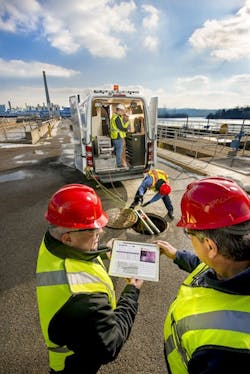Simplifying Pipeline Assessment Certification Program (PACP) Coding for Operators
About the author:
Mike Russin is general manager in the Americas for WinCan. Russin can be reached at [email protected].
Wastewater systems are vital to maintaining the health of a community. We depend on them to carry waste, runoff and pollutants away from population centers to a place of final treatment or disposal. However, because wastewater systems require frequent maintenance, being able to efficiently assess and document maintenance and rehab is crucial to meeting this need.
The Pipeline Assessment Certification Program (PACP) is the North American Standard for identifying and assessing defects in pipes. The program was developed to provide a standardized coding format for classifying, evaluating and managing pipeline conditions in a consistent and reliable manner.
The detail inherent to PACP coding allows its users to record different sets of information about a pipe’s condition. Tracking operation and maintenance (O&M) challenges is one of the most important uses of this coding. O&M defects are some of the most crucial to identify and address early, and resolving these defects can prevent potential operational disruptions, as well as increased rates of deterioration.
PACP Codes
Defects that fall into the O&M category typically include foreign objects found in pipes that may interfere with the operation of the system. These defects include deposits that are settled, attached in ingressed (DS/DA/DN); roots (R); infiltration (I); obstacles/obstructions (OB); vermin (V); and testing and grouting (G).
Keeping track of all PACP codes can be difficult. Having sufficient training and helpful resources in the field and office when documenting defects can ensure accurate documentation by operators, engineers and superintendents.
Using a standardized format like PACP can bring a number of benefits, including more proactive maintenance, more effective management of resources, and consistency in recordkeeping from system to system and operator to operator.
Yet, the overarching benefit of PACP lies in taking qualitative data—subjective, interpreted or investigated information often based on what an individual has seen—and using the program to convert it into quantitative data—often represented numerically—for objective analysis. Without consistent data, it is challenging to track the progression of sewer failure, prioritize maintenance and communicate across teams.
A department that tracks assessment data over time can identify weaknesses before they become problems, and plan based on expected needs for labor and resources years in advance. It takes the process of observation and provides structure so that users can identify, classify, prioritize and prepare to address their defects. The result is increased efficiency and effectiveness across a range of maintenance, rehab and budgeting functions.
Reporting Data
There are several ways to create a PACP-compliant report for a sewer system’s pipes. With an inspection crawler, an inspection crew has the ability to log observations using the PACP coding system as the camera drives through the pipe. Alternatively, operators can gather the inspection footage and wait for an engineer or supervisor to review and code it back in the office, once they have completed the inspection.
That data then can be uploaded into a sewer asset management software system that aggregates, standardizes and stores records. The most robust and advanced systems can verify all required coding information is uploaded correctly and a compliant report is generated.
However they go about coding, supervisors can use the data gathered with PACP to assign personnel and other resources to address specific issues. Not only are the specific defects clearly laid out in the software in a format that everyone involved can understand, but the location of each defect is documented as well. Modern systems can even present that data in GIS mapping software such as Esri ArcGIS, so operators can quickly identify troublesome areas.
Once the data is displayed on the map, it is easy to locate clusters of defects like infiltration or roots. Site investigations can then be performed to determine what is causing the rise in defects in these areas and whether the impacted pipes need more than routine maintenance or cleaning.
For example, an area with high infiltration could mean freshwater may be coming in from a third-party source, such as a fire hydrant or even a floodplain.
When using PACP, engineers also are required to grade a pipe’s condition using a 1 to 5 risk assessment, with 1 representing a “minor” defect and 5 representing a “significant defect.” Being able to quickly identify the major maintenance and operation needs in a system’s pipelines using quantitative data ensures that personnel and other resources are being used in the highest priority places.
For example, when roots enter a pipe through defects in the pipe wall, pipe connections, pipe joints or service laterals, the severity of the defect can vary greatly depending on its size. A “Roots - Ball” (RB) is defined as roots that have formed a mass, typically in the shape of a ball, that have the potential to severely restrict flow. This would likely be rated a 5. A “Roots - Fine” (RF) designation indicates a small quantity of roots that are unlikely to cause much damage and may be rated closer to a 1. However, noting the presence of small defects alerts departments to a potential problem and allows them to monitor the situation in the future.
Displaying this information on a computer-generated map also can assist crews in deciding on a resolution. Roots thrive in sewer pipes because of the heat, water and nutrients, so when they have an opportunity to gravitate toward pipes, they will. They also lead to the build-up of other defects, including grease and solid matters, that can clog pipes.
Depending on the severity of the defect and an operator’s budget, roots can be removed with a root cutting system or treated with chemicals, or the pipe can be completely rehabilitated or replaced. While annual maintenance is most frequently the cheapest method for root repair, operators will eventually pursue pipe rehab or replacement. This is most necessary around more clustered areas with larger root blockages that can cause more serious harm long-term. Data collected over time helps point the decision-maker in the right direction by identifying routinely problematic areas versus areas with first-time defects.
Staying on top of a wastewater system’s operation and maintenance needs is essential to maintaining the health of a community. Unaddressed defects can lead to serious consequences ranging from flooded homes to the spread of life-threatening pathogens.
With programs such as PACP and reliable software to store and analyze inspection data, crucial maintenance can be a proactive process rather than a reactive one.
Having a sewer system’s data in one accessible location that is easy to visualize and understand builds the foundation for a well-maintained system that will be viable and efficient long-term.



